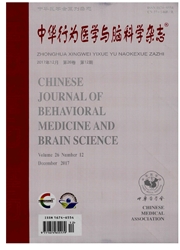

 中文摘要:
中文摘要:
目的探讨葡萄糖降解产物甲基乙二醛(MG)对海马神经元的毒性作用及可能机制。方法取新生24h Sprague-Dawley大鼠海马神经元原代培养至第7天,给予MG干预24h,四甲基偶氮唑蓝(MTT)法检测海马神经元存活率,异硫氰酸荧光素标记的膜联蛋白V联合碘化丙啶(PI)法检测海马神经元的凋亡率,采用实时RT—PCR法及Western印迹法测定脑源性神经营养因子(BDNF)及其受体酪氨酸蛋白激酶(TrkB)mRNA和蛋白表达水平。结果 1.随着MG浓度的增加及干预时间延长,海马神经元存活率逐渐降低,呈浓度依赖性(r=0.946,P〈0.01)和时间依赖性(r=0.993,P〈0.01)。与0h组海马神经元凋亡率(1.633±0.153)%相比,100μ MMG干预2h、6h、12h和24h后,其凋亡率逐渐增加[分别为(2.833±0.153)%、(3.367±0.153)%、(4.433±0.404)%和(8.833±0.306)%;均P〈0.01];2.与同时间对照组相比,MG干预12h组及24h组海马神经元BDNFmRNA及蛋白表达增加(P〈0.05或P〈0.01);而MG干预6h组、12h及24h组TrkBmRNA及蛋白表达减少(P〈0.05或P〈0.01)。结论MG对海马神经元具有直接毒性作用,可能首先抑制海马神经元TrKB表达,导致BDNF表达代偿性增高,损伤BDNF-TrKB通路,诱导神经元凋亡增加。
 英文摘要:
英文摘要:
Objective To investigate the mechanisms of methylglyoxal(MG)-induced injury of hippocampal neurons. Methods Primary cultured of hippocampal neurons from 1-day-old Sprague-Dawley rats were incubated with MG for different time and dose period, Cells proliferation were assayed by methyl thiazolyl tetrazolium (MTI') ,and apoptosis was quantified by flow cytometer using annexin V-FITC and propidium iodide (PI) staining. The protein and mRNA levels of brain-derived neurotrophic factor (BDNF) and tyrosine kinase B (TrkB) were assayed with Western Blotting and real-time PCR. Results Treatment with MG resulted in a concentration- dependent (r = 0. 946, P 〈 0.01 ) and time-dependent (r = 0. 993, P 〈 0.01 ) decreasing neurons viability. Compared with Oh group( 1. 633 ± 0. 153 ) % , 100 μM MG treatment for 2h ,6h, 12h and 24h ,the cellular apoptosis rate were significantly increased((2. 833±0.153)%,(3.367 ±0. 153)%,(4.433 ±0.404)% and (8.833± 0. 306)% respectively, all P 〈 0.01 ). MG also increased the BDNF mRNA and protein expression after 12h treatment (P 〈 0.05 or P〈 0.01 ) , but decreased the TrkB mRNA and protein expression in the cells after 6h treatlnent (P 〈 0.05 or P 〈 0. 01 ). Conclusion MG has direct toxic effect on bippoeampal neurons and can impaire the BD- NF-TrkB signal pathway by inhibiting the expression of TrkB, and increasing the apoptosis of hippoeampal neurons.
 同期刊论文项目
同期刊论文项目
 同项目期刊论文
同项目期刊论文
 Adolescent escitalopram administration modifies neurochemical alterations in the hippocampus of mate
Adolescent escitalopram administration modifies neurochemical alterations in the hippocampus of mate Genetic Variation in Apolipoprotein E Alters Regional Gray Matter Volumes in Remitted Late-onset Dep
Genetic Variation in Apolipoprotein E Alters Regional Gray Matter Volumes in Remitted Late-onset Dep A preliminary association study between brain-derived neurotrophic factor (BDNF) haplotype and late-
A preliminary association study between brain-derived neurotrophic factor (BDNF) haplotype and late- Abnormal integrity of long association fiber tracts are associated with cognitive deficits in remitt
Abnormal integrity of long association fiber tracts are associated with cognitive deficits in remitt Hippocampal neurochemistry is involved in the behavioural effects of neonatal maternal separation an
Hippocampal neurochemistry is involved in the behavioural effects of neonatal maternal separation an Hippocampal neurogenesis and behavioural studies in adult ischemic rat response to chronic mild stre
Hippocampal neurogenesis and behavioural studies in adult ischemic rat response to chronic mild stre Regional gray matter changes are associated with cognitive deficits in remitted geriatric depression
Regional gray matter changes are associated with cognitive deficits in remitted geriatric depression 期刊信息
期刊信息
